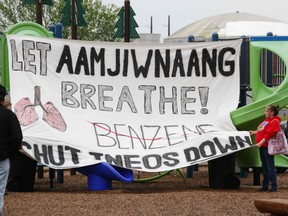Aamjiwnaang First Nation has issued a “notice of violation” to a chemical company in Sarnia and Ontario’s Environment Ministry.

Aamjiwnaang First Nation has issued a “notice of violation” to a chemical company in Sarnia and Ontario’s Environment Ministry.
Advertisement 2
Article content
First Nation officials announced the notice Friday, days after the ministry said it was suspending Ineos Styrolution’s environmental compliance approval amid continuing high benzene levels despite previous provincial orders for corrective action.
Article content
The ministry suspension keeps the already temporarily shuttered plant idle until it removes all benzene storage, repairs leaky equipment, installs vapor control measures, and comes up with a comprehensive benzene monitoring and community notification plan, a ministry statement said.
Benzene, a natural component of petroleum, is primarily used to make polystyrene, according to britannica.com. It is highly toxic, a known carcinogen and exposure to it may cause leukemia.
Advertisement 3
Article content
The band notice, “issued under Aamjiwnaang’s inherent right to self-government, and to protect its lands and resources for future generations,” seeks “immediate remediation of benzene emissions,” Aamjiwnaang Coun. Janelle Nahmabin said.
“The bottom line is it (identifies) the failures of the environmental regulators to protect Aamjiwnaang air quality,” said Scott Grant, an air pollution control engineer with Toronto-based C and S Grant Environmental Consulting.
“It’s clear the environmental regulators have not been enforcing the standards and air pollution control requirements for facilities in the area,” he said.
Among the notice’s calls for action is properly ventilating fumes from benzene storage tanks, Grant said.
Advertisement 4
Article content
Recommended from Editorial
Aamjiwnaang officials recently announced the band would shutter some of its buildings if benzene emissions reach 27 micrograms per cubic meter, he said.
“The health-based standard (in Ontario) for benzene is 0.45 and on April 25 (one of the Aamjiwnaang-based air monitors) showed a benzene level of 191,” or more than 400 times as high, Nahmabin said, adding Aamjiwnaang has not been consulted on ministry orders, including the most recent one suspending Ineos’ operations.
That order is a step in the right direction, but “it’s been proven, time and time again, that excluding Aamjiwnaang from the decision-making table has not been most helpful in looking out for our community’s health,” she said.
Advertisement 5
Article content
“It’s noticeable with four (ministry) orders now being issued (against Ineos during a period of years) and benzene still being a serious concern.”

Past ministry orders for the company have capped benzene emissions at 580 micrograms per cubic meter per hour, and more recently at 90, Grant said.
The band’s notice of violation recommends a limit of 5.6 micrograms per cubic meter per hour, he said. “And shut (the plant) down again at 12 micrograms. . . We believe this will help protect the community and we’re looking for our partners at the federal level and the provincial level to help us implement this.”
Ineos said this week its data shows no benzene emissions above prescribed limits, after Aamjiwnaang officials called for the plant to be shut down April 16 when monitors detected benzene spikes and community members reported headaches, nausea and dizziness.
Advertisement 6
Article content
“Know that those are not our limits,” Nahmabin said Friday, near the Aamjiwnaang band office, across the road from the Ineos plant. “And the moment that benzene emissions cross that road. . . our aboriginal inherent rights are impacted.
“We want to be afforded the basic human right to clean air, along with every other person here in Canada,” she said. “We’re not sure why we’re still having to prove that.”

After Aamjiwnaang called for the plant shutdown April 16, the Environment Ministry issued several orders April 18 for the company about benzene control and public notification.
The ministry’s most recent order to Ineos Styrolution, issued April 18, requires the company to develop a plan to “prevent, reduce and eliminate the discharge of benzene from wastewater at the facility” by Friday.
Advertisement 7
Article content
It was ordered to put procedures in place by May 3 to notify the public when benzene concentrations in the airexceed defined thresholds.”
It also was ordered to investigate other sources of benzene emissions and act to “prevent, decrease and eliminate the discharge.”A plan for that is required by May 17.
Orders were issued to Ineos in Sarnia in 2019, 2022, 2023 and last month, ministry spokesperson Gary Wheeler said in an email.
Suspension orders are rare, with the ministry issuing four overall in the last decade, Wheeler said.
Ineos announced April 20 it was temporarily closing its Sarnia site for maintenance and to address a mechanical issue.

Aamjiwnaang declared a local state of emergency April 25 due to ongoing benzene emissions.
Advertisement 8
Article content
A Sarnia-area environmental health project report released by the ministry earlier this year said there is an increased risk of leukemia from benzene levels in the air in some areas of Sarnia and Aamjiwnaang, and recommended Ontario improve regulatory enforcement.
Daily meetings with the provincial Environment Ministry and other government representatives continue, enabled by that emergency declaration, Aamjiwnaang Chief Chris Plain said.
“Once activated, it just allows us to be in contact and receive additional resources from sources that don’t normally provide them,” he said.
After meeting with Ineos officials recently, company officials didn’t seem to recognize the seriousness of the First Nation’s concerns, he said.
“We can’t really trust that company’s word at this point,” he said.
“Our focus now is dealing with the ministries to make sure that the company comes into compliance.”
Article content


